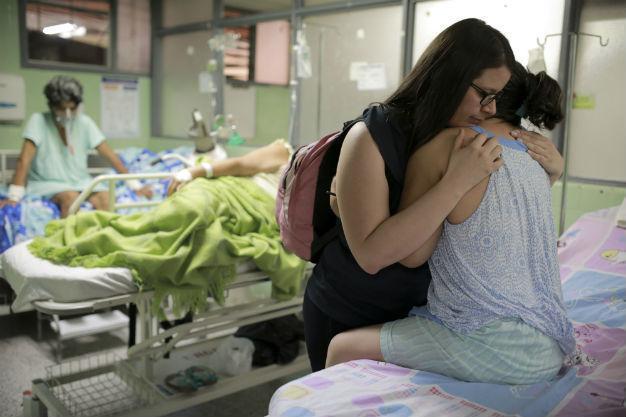US-Brazil teams probe link between Zika and microcephaly
JOAO PESSAO, Brazil – The Associated Press

AP photo
Joint teams of U.S. and Brazilian health workers will fan out across one of Brazil’s poorest states Feb. 23 in search of mothers and infants for a study aimed at determining whether the Zika virus is causing babies to be born with unusually small heads.Brazil’s health minister, Marcelo Castro, says he is “absolutely sure” mosquito-borne Zika is responsible for a spike in cases of the rare birth defect microcephaly, which sees babies born with small heads and brains and can cause severe developmental problems. But with scant scientific literature published on the matter, some doctors in Brazil and elsewhere say there is not yet enough scientific data to prove the connection.
Jointly run by the Brazil’s Health Ministry and the U.S. Centers for Disease Control and Prevention, the study is intended to fill that vacuum by comparing babies with microcephaly and their mothers to babies without the condition.
The popular “understanding is that Zika virus [behind the microcephaly spike]. How much of that is Zika virus is really one of the important goals of this study,” said Erin Staples, a Colorado-based epidemiologist who heads the CDC contingent in Paraiba state. “I do believe there is something occurring that is unique and knowable, but we really need to understand better, mostly so we can prevent this from happening to other generations.”
Eight teams made up of one CDC staffer and three Brazilian health workers will knock on the doors of several hundred randomly selected families with infants throughout Paraiba, a northeastern coastal state that is one of Brazil’s least developed. The teams hope to recruit at least 130 babies with microcephaly and their mothers and two to three times that number of mothers and babies without the condition, all born in the same areas and at around the same time.
The researchers will take blood samples from mothers and babies that will be sent to labs in Brazil and the United States to test for Zika and dengue, a similar virus also transmitted by the Aedes aegypti mosquito. The idea is to determine whether mothers whose babies have microcephaly were infected with Zika and, if so, when during their pregnancies.
Teams will also be on the lookout for other factors that, possibly in conjunction with Zika, could be behind Brazil’s increase in microcephaly, such as a prior infection with dengue, toxoplasmosis or the ingestion of toxins.
“If we can provide some basic information or show a potential association, that will allow us another avenue of how do we prevent this and what do we need to do next,” Staples said.
The recruitment process is expected to take four to five weeks, but the timetable will largely depend on how receptive potential subjects are.
At a training session Monday in the state capital of Joao Pessoa, the field teams rehearsed how they will reach out to families and discussed ethical concerns, including how to react to reticence from potential subjects and how many times it is OK to prick babies to try to draw blood.
The language barrier proved a stumbling block at the training session, with the Brazilians and Americans team members often resorting to pantomime as they ran through the scripts they are to recite to potential subjects in this Portuguese-speaking nation.
Priscila Leite, who leads the Health Ministry’s contingent, said she expects recruitment numbers to be high given the level of alarm about Zika in Brazil - particularly here in the northeast, the epicenter of the country’s Zika and microcephaly outbreaks.
“There is a lot of anxiety out there, and people really want to understand what’s going on,” she said.
In Paraiba alone, 56 cases of microcephaly have been confirmed since October and 423 suspected cases are under investigation, the Health Ministry says. In previous years, Brazil tended to average around 150 cases nationwide.
Brazil to fight Zika with zapping mosquitoes
Meanwhile, Brazil is planning to fight the Zika virus by zapping millions of male mosquitoes with gamma rays to sterilize them and stop the spread of the virus linked to thousands of birth defects.
Called an irradiator, the device has been used to control fruit flies on the Portuguese island of Madeira. The International Atomic Energy Agency said on Monday it will pay to ship the device to Juazeiro, in the northeastern state of Bahia, as soon as the Brazilian government issues an import permit.
“It’s a birth control method, the equivalent of family planning for humans,” Kostas Bourtzis, a molecular biologist with the IAEA’s insect pest control laboratory, told Reuters.
U.S. President Barack Obama Feb. 22 sent lawmakers an official $1.9 billion request to combat the spread of the Zika virus in Latin America and the U.S.
He also requested flexibility to use a limited portion of leftover funds provided in 2014 to fight Ebola to take on Zika.
Top House Republicans told the White House last week that the quickest way to get the money to fight Zika would be to use some of the approximate $2.7 billion that had been designated for the Ebola crisis but remains “unobligated.” Consideration of a stand-alone Zika request could prove cumbersome, especially in a combative election year.
















